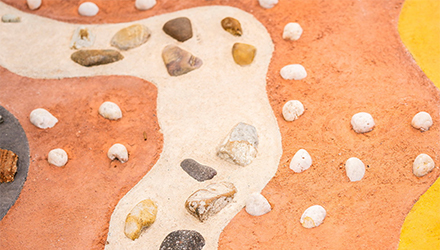This week is NAIDOC Week, which marks a significant observance and calls for celebration of the history, culture and achievements of Aboriginal and Torres Strait Islander peoples.
Indigenous leaders in the ANU community consider NAIDOC Week to be a time of celebration and recognition for Indigenous people, by Indigenous people.
NAIDOC week for non-Indigenous people can then be a time of cultural learning and commitment to building cultural competency - so we thought we could share some thinking about giving Acknowledgements of Country when you are not Indigenous.
If you have ever run an event, you might have been responsible for doing an Acknowledgement of Country, or you might have heard people give different variations of these.
ANU has a commitment to ensuring that all key and flagship events have a Welcome to Country delivered at them by a Traditional Custodian where possible. If the event is of a smaller scale, and there is not a Welcome then an Acknowledgement of Country should always be made.
The difference between a Welcome to Country and an Acknowledgement of Country is, essentially, who can give one.
Welcome to Country
Welcome to Country can only be given by a Traditional Custodian of the land you are on. It signifies an invitation onto their land and granting safe passage. With permission, other members of a nation who are not Traditional Custodians can give a welcome on their behalf. A Welcome is sometimes also accompanied by a Smoking Ceremony, to cleanse the energy of those being welcomed.
Acknowledgement of Country
Acknowledgement of Country can be said by anyone, Indigenous or non-Indigenous. It is about respecting the Traditional Custodians of a specific place, their country, and their history. When you acknowledge Country you also acknowledge the Elders of that place and their Lore, promising to respect the land while you’re on it.
Over the last few years there have been some shifts in the norms for the Acknowledgement including a shift away from including ‘emerging’ when paying respect to the Elders past and present.
Thinking has moved on from this and many Indigenous people have highlighted it is not appropriate say emerging, as most First Nations do not have a ‘category’ of emerging elders.
Furthermore, we are encouraged to remove mentions of First ‘Australians’ as many Indigenous people do not identify with Australia, often calling it ‘so-called Australia’. Indigenous people lived on this land before it was colonised and named Australia.
When giving an Acknowledgement, ensure that you also always make specific mention of the nation on whose land the event is happening. For the University’s Canberra campus, it is Ngunnawal and Ngambri land. If it is an online event also note that the event occurs in many nations and list them where possible or invite participants to note them, even invite them to type them into the chat.
It is recommended that anyone who is running an event and giving an Acknowledgment always researchers where the event will be held and to say the name of the place. That is the bare minimum, it takes two seconds on Google, and if you do it in advance you can practice the pronunciation.
If you want to go the extra mile, when you are doing a specific event for a specific audience, you can also do some research about the local nation and think about whether there is a particular insight that is relevant that relates to your subject matter.
For instance, is the event about technology? Then you could discuss how Indigenous people were some of the first agricultural engineers and designers, building animal traps and systems for land management. If the event is about women, you might reflect on the role of women in the local nation, did they play a significant role in storytelling and oral history making. Or if the event is in a special place, check if it is on a song line or near a scared meeting place - like how ANU is on the Songline of the Bogong Moth.
The best Acknowledgements of Country do literally that, they acknowledge the country – and show an appreciation for the 60,000 years of history that predates white settlement. That can be done by anyone!
If you want something to cut and paste for templates this is the current model:
We acknowledge and celebrate the First People on whose traditional lands, the [Ngunnawal and Ngambri people] on which we meet and pay our respect to the Elders past and present.
However, if you want to do a little extra, why not take every Acknowledgement of Country as an opportunity to, engage, research, learn and acknowledge the history of the First People of the land you will be meeting on.

